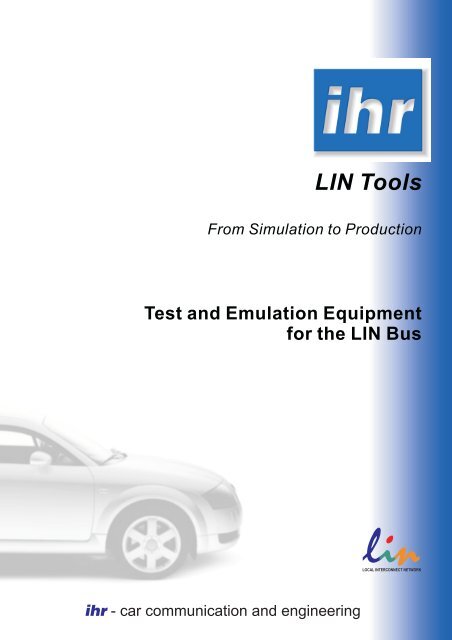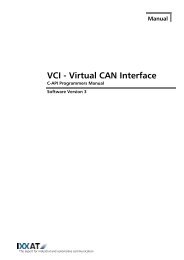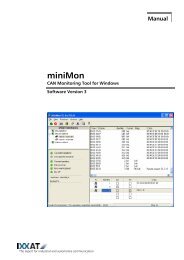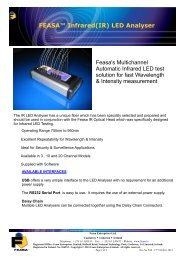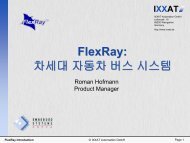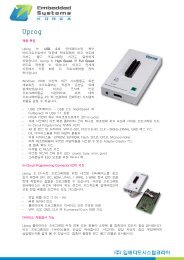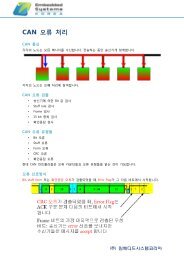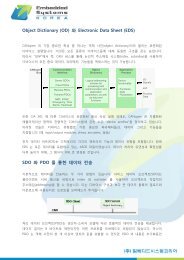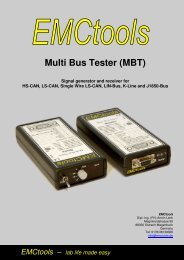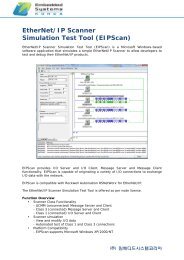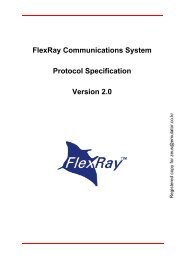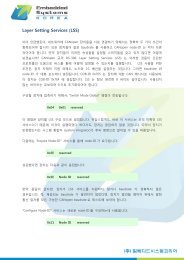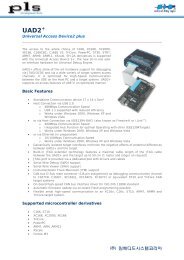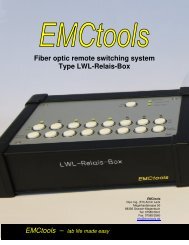LIN Tools
LIN Tools
LIN Tools
You also want an ePaper? Increase the reach of your titles
YUMPU automatically turns print PDFs into web optimized ePapers that Google loves.
Test and Emulation Equipment<br />
for the <strong>LIN</strong> Bus<br />
ihr - car communication and engineering<br />
<strong>LIN</strong> <strong>Tools</strong><br />
From Simulation to Production<br />
LOCAL INTERCONNECT NETWORK
2<br />
<strong>LIN</strong><br />
Configuration<br />
<strong>LIN</strong> Subnet<br />
<strong>LIN</strong> frames<br />
Signals<br />
<strong>LIN</strong><br />
controller +<br />
transceiver<br />
CAN<br />
Configuration<br />
Event Controlled Signal Matrix<br />
CAN Subnet<br />
(optional)<br />
CAN frames<br />
Signals<br />
CAN 2<br />
controller +<br />
transceiver<br />
<strong>LIN</strong> Bus CAN2 Bus<br />
Event<br />
Configuration<br />
Signals<br />
System<br />
Subnet<br />
control + status<br />
analog/digital<br />
in/out<br />
Signals<br />
Hardware I/O<br />
Subnet<br />
I/O Signals<br />
HW I/O<br />
driver +<br />
ports<br />
Panel
<strong>LIN</strong> Emulators for Development, Test Stations, Field Tests, and Production<br />
THE family of tools for the entire development process of automobile control devices<br />
Simulate a complete <strong>LIN</strong> bus in order to get to know and<br />
familiarize yourself with the technology. Develop a<br />
control device and check the bus protocol. Thoroughly<br />
check your development. Simulate errors and create<br />
protocols. Qualify your <strong>LIN</strong> implementation. Test your<br />
control device in continuous usage and in actual<br />
vehicles. Test your product both in productive and<br />
quality assurance environments. You can either use<br />
many different tools for these purposes - or just one!<br />
The needs of our users are different<br />
--- so are our emulators.<br />
ihr <strong>LIN</strong> emulators are available in a number of various<br />
forms. Whether you need a fully mobile hand-held<br />
device or an interface for the assembly line, a slim<br />
communication accessory or even a fully equipped<br />
high-performance analysis device - we have the<br />
solution for your requirements.<br />
Our users want to work together with one another<br />
--- our emulators do just that.<br />
All of our emulators are based on the same operating<br />
system and emulator core. For you, this translates to<br />
effective use of the know-how you acquire. The<br />
developers of a control device can pass on the<br />
configuration they have created to other users. Your<br />
test centers and production lines use devices that are<br />
compatible with those used in development. This<br />
enables you to save work effort and organize your<br />
development processes more efficiently.<br />
3
4<br />
Key Features<br />
All devices are designed as development tools for the<br />
implementation and test of <strong>LIN</strong> control devices and entire<br />
networks. At the same time, they are multifunctional and<br />
can be configured according to your requirements.<br />
Flexibility<br />
The tools can be equally well used as passive analyzers<br />
or for the active depiction of single or multiple <strong>LIN</strong> nodes,<br />
irrespective of whether as master or slave (simulation of<br />
bus participants not actually present). All devices are fully<br />
configurable and programmable. Any kind of <strong>LIN</strong><br />
networks may be processed as desired. All peripheral<br />
resources (entry keys, display LED's, I/O ports,<br />
depending on the model) are freely configurable. They<br />
can be coupled or linked with <strong>LIN</strong> signals and also with<br />
system variables and events such as, for example, error<br />
messages, control parameters and measurement values.<br />
A flexible set of commands allows the use of event-based<br />
counter and timing functions, arithmetic and logical<br />
operations, threshold value checks, and number<br />
comparisons with all <strong>LIN</strong> and system signals. It is even<br />
possible to create simple sequence controls.<br />
Mobility<br />
The devices work fully autonomously, without need of<br />
being connected to the PC. The large input voltage range<br />
allows the unproblematic use in both vehicles and<br />
automation areas up to 24V. The robust housing with<br />
IP53 protection resists even rough environmental<br />
conditions. A connection to the PC need only be<br />
established for the download of the previously created<br />
configuration of <strong>LIN</strong> network descriptions and the<br />
emulator periphery. The CAN interface required for this is<br />
included in the scope of delivery.<br />
Precision<br />
A high-performance 16bit microcontroller operates the<br />
<strong>LIN</strong> protocol in a very precise, but nevertheless highly<br />
versatile manner. With an internal access time resolution<br />
of 333ns, the emulator can generate and measure every<br />
bit edge with a precision of
Performance Characteristics<br />
Hardware<br />
Basic device with 16bit computer, voltage supply 8..24V,<br />
designed for automobile environment and industrial usage (SPS)<br />
Emulin <strong>LIN</strong>gate<br />
+<br />
<strong>LIN</strong>gate<br />
basic<br />
Overview<br />
<strong>LIN</strong> log <strong>LIN</strong> I/O<br />
<br />
<strong>LIN</strong> interface with transceiver, freely programmable 1000 – 20000 Baud <br />
<strong>LIN</strong> bus termination variable, can be set by software<br />
Resistive: 310Ohm..30kOhm (15 steps)<br />
Capacitive: 100pF .. 13nF (10 steps)<br />
<strong>LIN</strong> bus termination selectable via software (4 steps):<br />
Master 1kOhm / Slave 30kOhm / Stress 470 Ohm / Overload 310 Ohm<br />
CAN interface 1MBaud (measurement bus) for communication with PC /<br />
external participants, max.15 emulators on the net<br />
<br />
<br />
<br />
RS232 interface for firmware updates <br />
Operating panel with 8 keys and 12 LED's, freely configurable <br />
Menu-based LCD display for adjustment and visualization of parameters,<br />
<br />
frames and signals<br />
Operating panel with control keys and status displays for logging data <br />
Card slot for flash memory media <br />
Desktop housing cast aluminium, IP53, 195 x 145 x 60mm <br />
Top hat rail housing, 210 x 105 x 30mm <br />
Software Functions<br />
Operating system with active independent <strong>LIN</strong> emulator,<br />
- Capable of stand-alone operation, configurable via PC<br />
- <strong>LIN</strong> environment can be loaded (from <strong>LIN</strong> description file)<br />
- Event-based function sequences (Event Description Files) can be created<br />
- Static configuration of the system and protocol parameters (start values)<br />
- Automatic time synchronization of the emulators on common CAN<br />
<br />
Number of the configuration data sets / locally switchable 2/ 1/- 1/- 1/- 1/-<br />
Read and write <strong>LIN</strong> messages and signals via emulator-CAN <br />
Read system states, measurement values from <strong>LIN</strong> protocol via emulator-<br />
CAN<br />
<br />
Read and write protocol parameters during runtime via emulator-CAN <br />
Wakeup – Sleep capable / Power – Down capable<br />
(Power-Down only possible with <strong>LIN</strong> transceiver,<br />
otherwise only bus sleep when emulator running)<br />
Local parameter adjustment, measurement,<br />
signal visualization and adjustment<br />
/ / / / /<br />
<br />
Read and write hardware ports via emulator-CAN <br />
Read and write vehicle CAN bus data via emulator-CAN,<br />
Event-based function configuration for vehicle CAN<br />
Periphery Options<br />
Port interface: 2 digital/analog inputs, 2 digital/analog outputs (BNC) of which<br />
1 output configurable as frame trigger<br />
Digital I/O module: 16 optically isolated I/O connections, 2 separate voltage<br />
ranges 5..24V, row clamp connectors<br />
(available only together with port interface)<br />
Secondary CAN interface for vehicle bus: selectable high-speed/low-speed,<br />
for monitoring and emulation of gateway control devices<br />
/ / <br />
<br />
/ <br />
/ / <br />
Scope of Delivery<br />
<strong>LIN</strong> Emulator in desktop/handheld housing <br />
<strong>LIN</strong> Emulator in industrial housing for top hat rail assembly <br />
PC software "Visulin" for configuration and analysis<br />
<br />
For Windows 9x/ME/NT4/2000/XP<br />
CAN interface adapter for PC parallel port (in standard scope of delivery) <br />
CAN interface for PC ISA / PCI / USB (on request) <br />
Cable set for CAN and <strong>LIN</strong> <br />
Additional mains supply adapter unit 12V <br />
included in standard<br />
optional when placing new order<br />
can be upgraded (upgrade package)<br />
not present / not available<br />
Status: 02/2002. All properties are subject to change without prior notice as a result of further technical development<br />
5
6<br />
Development <strong>Tools</strong><br />
Performance Characteristics:<br />
Equipment:<br />
Accessories:<br />
<strong>LIN</strong>gate+<br />
Not all applications need the full functionality of control<br />
parameters and analysis functions. <strong>LIN</strong>gate+ is perfectly<br />
adapted for use as an operating and display device there<br />
where real control devices are missing. It can simulate<br />
masters and /or slaves, and thus physically rounds off a<br />
<strong>LIN</strong> network. The configurable signal processing makes<br />
it possible to simulate genuine control device behavior,<br />
ranging from direct reactions to simple sequence<br />
controls to adjustment controllers. <strong>LIN</strong>gate+ is thus<br />
much more than just an operating interface.<br />
The top model Emulin is an autonomous test and simulation<br />
device. Almost all test and control tasks on a <strong>LIN</strong> bus can be<br />
carried out with complete mobility. Primary fields of use are<br />
the developer's workplace, the test station, and the direct<br />
measurement in the vehicle. Above all, users appreciate<br />
the direct access to all timing parameters and signals during<br />
the measurement. This permits rapid error finding on site -without<br />
the bother of connecting to the PC.<br />
Emulation and Analysis of <strong>LIN</strong> nodes / <strong>LIN</strong> subsystems, simulation of bus participants not actually present<br />
Local monitoring of the bus traffic<br />
Local adjustment and measurement of all control parameters, message signals, frame timing<br />
Two independent configuration data sets, locally switchable<br />
Wakeup / Sleep / Power Down<br />
Event-based signal configuration and sequence control<br />
Detailed <strong>LIN</strong> bus error recognition and monitoring<br />
PC program Visulin for recording and displaying measurement data, and also for configuring the emulator<br />
Simple integration into automated test environments (LabView, HP VEE, and others)<br />
Simulation of erroneous bus adjustment (stress, overload)<br />
Menu-based illuminated Display<br />
Operating panel with 8 keys and 12 LED's, freely configurable<br />
Port interface with 2 analog / digital inputs and outputs<br />
Frame-based trigger pulse creation via digital output<br />
Highly variable bus termination ranges (resistive + capacitive)<br />
High-speed CAN measurement bus for PC communication<br />
Secondary CAN interface for vehicle bus and gateway emulation, fully configurable<br />
Digital I/O module<br />
CAN I/O periphery extension
Performance Characteristics of <strong>LIN</strong>gate+:<br />
Emulation and analysis of <strong>LIN</strong> nodes / <strong>LIN</strong> subsystems, simulation of bus participants not actually present<br />
Wakeup / Sleep / Power Down<br />
Event-based signal configuration and sequence control<br />
Detailed <strong>LIN</strong> bus error recognition, LED display possible<br />
PC software Visulin for recording and displaying measurement data, and also for configuring the emulator<br />
Simple integration into automated test environments (LabView, HP VEE, and others)<br />
Equipment:<br />
Operating panel with 8 keys and 12 LED's, freely configurable<br />
Resistive bus termination (master/slave/stress/overload) switchable by means of software<br />
Accessories:<br />
Secondary CAN interface for vehicle bus and gateway emulation, fully configurable<br />
Port interface with 2 analog / digital inputs and outputs, trigger creation<br />
Digital I/O module<br />
CAN I/O periphery extension<br />
Test Field and Continuous Run<br />
Performance Characteristics:<br />
Equipment:<br />
Accessories:<br />
<strong>LIN</strong> log<br />
The mobile <strong>LIN</strong> data logger monitors the bus traffic in the<br />
lab or in the moving vehicle. Flash memory cards serve<br />
as an exchangeable recording medium. These are then<br />
read into the PC and processed and analyzed by the<br />
integrated user interface Visulin. Trigger conditions are<br />
configured on the PC and loaded to the logger together<br />
with the <strong>LIN</strong> description. The devices can be cascaded,<br />
so that the time synchronous parallel recording of<br />
several separate vehicle buses (<strong>LIN</strong> and CAN mixed) is<br />
possible. The recorded data from all sources are always<br />
time synchronous with one another.<br />
Monitoring of <strong>LIN</strong> nodes / <strong>LIN</strong> subsystems<br />
Recording of <strong>LIN</strong> bus traffic, system and measurement data, optional vehicle CAN bus traffic<br />
Wakeup / Sleep monitoring<br />
PC software Visulin for recording and displaying measurement data, and also for configuring the logger<br />
Operating interface with keys and LED's for direct logger control<br />
Card slot for insertion of compact flash media<br />
Memory depth of up to 128MB, permits the recording of more than 6 million messages<br />
Bus termination (master/slave/stress/overload) switchable by means of software<br />
Port interface with 2 analog / digital inputs and outputs, trigger creation<br />
Secondary CAN interface for vehicle bus and gateway emulation, fully configurable<br />
CAN I/O periphery extension<br />
7
8<br />
Performance Characteristics:<br />
Equipment:<br />
Accessories:<br />
<strong>LIN</strong>gate basic<br />
Program controlled test runs on test stations, whether<br />
continuous runs or end-of-line, rarely need an operating<br />
interface. In the case of computer-supported<br />
applications in which the PC or other CAN enabled<br />
automatic device takes over the control, the <strong>LIN</strong>gate<br />
basic represents the most favorable alternative from a<br />
price point of view. <strong>LIN</strong>gate basic provides a <strong>LIN</strong>-CAN<br />
message transfer to and from the measurement bus and<br />
takes care of the protocol. Passive operation is possible,<br />
whereby an external test computer takes over the <strong>LIN</strong><br />
scheduling via CAN.<br />
Emulation and analysis of <strong>LIN</strong> nodes / <strong>LIN</strong> subsystems, simulation of bus participants not actually present<br />
Wakeup / Sleep<br />
Event-based signal configuration and sequence control<br />
<strong>LIN</strong> bus error recognition, monitoring via CAN and LED possible<br />
PC software Visulin for recording and displaying measurement data, and also for configuring the emulator<br />
Simple integration into automated test environments (LabView, HP VEE, and others)<br />
Status display via 3 LED's<br />
Bus termination (master/slave/stress/overload) switchable by means of software<br />
Secondary CAN interface for vehicle bus and gateway emulation, fully configurable<br />
Port interface with 2 analog / digital inputs and outputs, trigger creation<br />
Digital I/O module<br />
CAN I/O periphery extension<br />
For Production and Automatic Testing Devices<br />
This device variation has been conceived for fixed<br />
installation on a rail or in a switch cabinet. <strong>LIN</strong> I/O is the<br />
intelligent communication adapter between production<br />
automation and the <strong>LIN</strong> test object. The connection to<br />
the tester or automation system is effected optionally via<br />
high-speed CAN and/or 24V digital I/O - in both cases<br />
optically isolated from the <strong>LIN</strong> test object. The test object<br />
can be fed in a short-circuit protected manner via the <strong>LIN</strong><br />
I/O. As a unique feature, the current consumption of the<br />
device under test is measured and can be used in the<br />
process.<br />
The internal signal processing makes it possible to preprocess<br />
the <strong>LIN</strong> data, for example for checking limiting<br />
values or signal plausibility, or for the end-of-line<br />
calibration of the control devices. The automation<br />
system can thus be freed up and the <strong>LIN</strong> interface can<br />
independently carry out simple sequences and deliver -<br />
for example - "good/bad" evaluations to the tester.<br />
In spite of the deviation in hardware appearance, the <strong>LIN</strong><br />
I/O is compatible with the other members of the family of<br />
tools.<br />
<strong>LIN</strong> I/O
Performance Characteristics of <strong>LIN</strong> I/O:<br />
Emulation and Analysis of <strong>LIN</strong> nodes / <strong>LIN</strong> subsystems, simulation of bus participants not actually present<br />
Wakeup / Sleep<br />
Event-based signal configuration and sequence control<br />
<strong>LIN</strong> bus error recognition, monitoring via CAN, LED and port possible<br />
PC software Visulin for recording and displaying measurement data, and also for configuring the emulator<br />
Simple integration into automated test environments (LabView, HP VEE, and others)<br />
Equipment:<br />
Status display via LED's<br />
Bus termination (master/slave/stress/overload) switchable by means of software<br />
16 galvanically separated digital inputs/outputs (like digital I/O module)<br />
LED status display for digital ports<br />
4 analog inputs<br />
2 analog outputs, trigger creation<br />
1 current measurement channel (1A) for current draw of the test object<br />
Housing for the top hat rail assembly, 200 x 105 mm<br />
Connectors designed as detachable row clamps<br />
Accessories:<br />
Secondary CAN interface for vehicle bus (optional when placing a new order)<br />
CAN I/O periphery extension<br />
Accessories for the Emulators<br />
Equipment:<br />
Digital I/O Module<br />
16 bidirectional input/outputs, divided into 2 ports with separate power supply<br />
Signal level and voltage supply ranges from 5V to 24V<br />
Galvanic separation from the emulator<br />
High-side driver, output performance max. 100mA/channel, cumulative up to 250mA/port<br />
Detachable row clamp connectors<br />
This module can extend the emulators Emulin, <strong>LIN</strong>gate+<br />
and <strong>LIN</strong>gate basic to take account of high demands on<br />
the number of digital inputs and outputs. All 16<br />
bidirectional inputs and outputs can be individually<br />
programmed and integrated into the emulator<br />
configuration. Thanks to optical isolation, a testing<br />
device or automation system can be connected in their<br />
own galvanic domains. The connection to digital<br />
sensors/actors provides endless possibilities for the<br />
simulation of a control device or the realization of a<br />
"black box" functional pattern.<br />
9
10<br />
CAN Interface This module extends all emulators by an additional,<br />
freely usable CAN interface, intentionally for the vehicle<br />
bus. High-speed and low-speed connections can be<br />
selected with the same component. Gateway control<br />
devices can be fully monitored and emulated. The PC<br />
software extension supports the use of CAN<br />
configuration files in DBC format. The emulators can<br />
autonomously exchange data between CAN and <strong>LIN</strong>.<br />
CAN messages can be preferentially filtered and are<br />
displayed on the CAN measurement bus together with<br />
the <strong>LIN</strong> data and system data.<br />
The CAN operation is completely independent from the<br />
presence of a <strong>LIN</strong> connection. Emulators with the CAN<br />
module can thus naturally also be used as pure CAN<br />
application tools and have the same possibilities for<br />
standalone and mobile operation.<br />
Performance Characteristics: Equipment:<br />
<br />
<br />
<br />
Freely configurable CAN environment,<br />
Baud rates from 25K to 1Mbaud<br />
Support for up to 14 active<br />
CAN messages with direct signal accessl<br />
Emulable gateway functions,<br />
signal and message transfer between CAN and <strong>LIN</strong><br />
CAN I/O<br />
CAN I/O is a periphery adapter for distributed process<br />
communication for automation on a 24Volt net. The<br />
place of assembly is the carry rail. Baud rates and<br />
applied standard CAN identifiers can be freely assigned.<br />
The device can thus be unproblematically integrated in<br />
existing CAN networks.<br />
If there is a high demand on input and output resources,<br />
CAN I/O can be connected to any <strong>LIN</strong> emulator via the<br />
high-speed CAN measurement bus. In this case the<br />
device functions as an external periphery module. The<br />
signal coupling/linking and processing are effected with<br />
the emulator as master.<br />
Performance Characteristics:<br />
<br />
<br />
Configurable CAN message parameters and identifiers<br />
for transmission and reception<br />
All I/O signals can be addressed by the emulator<br />
<br />
<br />
<br />
Dual transceiver for selectable<br />
high-speed / low-speed operation<br />
Exchangeable termination resistors<br />
for low-speed connection<br />
Firmware extension for the emulator,<br />
Software support through Visulin<br />
Equipment:<br />
16 digital inputs with LED status display<br />
16 digital input/outputs with LED status display<br />
2 analog inputs<br />
2 analog outputs<br />
High-speed CAN interface<br />
Power supply 24V +/- 10%<br />
Housing for top hat rail assembly, 185 x 105 mm
Visulin<br />
All functions for the configuration<br />
and analysis are combined under<br />
the integrated Visulin environment.<br />
The communication with one or<br />
more emulators is effected via a<br />
highspeed CAN measurement bus.<br />
Configuration:<br />
The <strong>LIN</strong> Emulator needs to be<br />
initially prepared for the task at<br />
hand. After selection of the<br />
environment description for <strong>LIN</strong><br />
and CAN bus description files,<br />
supplementary settings are made<br />
and periphery resources assigned.<br />
The emulator behavior is set by the<br />
creation of event-based command<br />
linking. When configuration is<br />
completed, Visulin transfers the<br />
complete config table to the<br />
emulator memory. There it can<br />
either be stored permanently in the<br />
Flexible event based operations<br />
flash ROM, or kept volatile in RAM<br />
for test purposes. After this an<br />
emulator can work fully<br />
autonomously with its configured<br />
application. All setting adjustments<br />
are managed and stored in project<br />
files.<br />
Real-time Monitoring:<br />
If the emulator remains connected<br />
with the PC during operation, then<br />
Visulin can read and display the<br />
entire <strong>LIN</strong> and CAN data traffic. The<br />
data is displayed in multiple<br />
message lists together with<br />
aquired timestamps. The<br />
signal contents are<br />
decoded and listed with the<br />
correct logical and physical<br />
representation as defined<br />
within the <strong>LIN</strong> description<br />
file. Signals, control<br />
parameters and hardware<br />
resources can be written<br />
and read interactively.<br />
Data Storage and<br />
Processing:<br />
Visulin processes both the files<br />
created from <strong>LIN</strong> log as well as the<br />
real-time data from the CAN<br />
measurement bus. Data streams<br />
can be filtered and then re-written<br />
to log files.<br />
Software Maintenance<br />
Visulin is under continual further<br />
development. More complex<br />
analysis functions and graphical<br />
visualization are currently in<br />
preparation. Visulin is an integral<br />
component of all emulator<br />
packages of the <strong>LIN</strong>tools family.<br />
Updates and supplementary<br />
documents are available to all<br />
users via the internet.<br />
Signal browser for initialization<br />
and the creation of event links<br />
11
Contact:<br />
ihr GmbH<br />
Daimlerstrasse 17<br />
D-77815 Bühl<br />
Tel. +49 7223 9964-0<br />
Fax. +49 7223 9964-50<br />
Email sales@ihr.de<br />
Web www.ihr.de<br />
Associated Member of the <strong>LIN</strong> Consortium<br />
ihr - car communication and engineering<br />
LOCAL INTERCONNECT NETWORK


